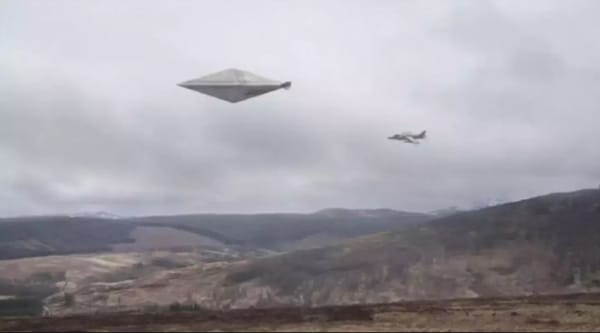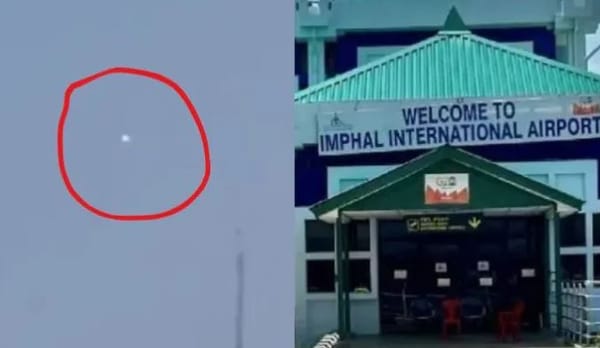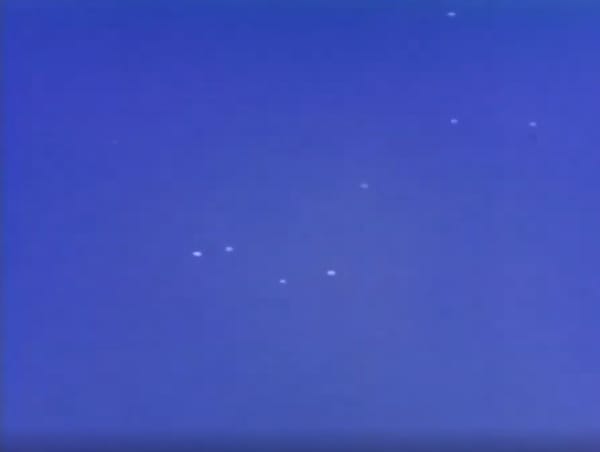The 1986 Japan Cargo UFO Sighting

On the evening of November 17, 1986, a seemingly routine cargo flight across the northern skies would soon become one of aviation's most compelling UFO cases. Japan Air Lines Flight 1628, a Boeing 747-200F en route from Paris to Tokyo with a stopover in Anchorage, Alaska, experienced an extraordinary and unexplained aerial phenomenon that has intrigued investigators and ufologists for decades.
As the aircraft cruised at 35,000 feet, Captain Kenju Terauchi, First Officer Takanori Tamiya, and Flight Engineer Yutaka Sato encountered a massive, luminous object that defied conventional aviation norms. Described as a rectangular-shaped craft with a series of glowing lights, the unidentified flying object not only dwarfed their Boeing 747 but also exhibited flight characteristics that appeared to challenge the capabilities of known technology. For approximately 50 minutes, the UFO followed the cargo plane, performing complex maneuvers and altering its speed in ways that left the crew and subsequent investigators bewildered.
The incident was more than just a fleeting sighting. It was accompanied by corroborating radar data from Anchorage Air Traffic Control, which tracked the object and confirmed its proximity to the aircraft. This radar confirmation provided a significant boost to the credibility of the crew's visual accounts, making it one of the few UFO encounters supported by both human observation and technological evidence.
As news of the sighting spread, the case drew considerable attention from both the media and authorities. Japanese and American officials conducted thorough investigations, yet the nature of the object and the reasons behind its unusual behavior remained elusive. The incident not only sparked public fascination but also raised questions about the potential for advanced, unidentified technologies and their implications for aviation safety.
In this article, we delve deeply into the Japan Cargo 747 UFO sighting, examining the detailed accounts of the crew, the corroborative radar data, and the investigations that followed. We explore the context of the sighting within the broader framework of UFO phenomena and its lasting impact on the field of aerial anomaly research. This extraordinary event, with its blend of eyewitness testimony and technical verification, continues to captivate and challenge our understanding of what lies beyond the conventional bounds of flight.
The Sighting
On the evening of November 17, 1986, Japan Air Lines Flight 1628, a cargo flight operating a Boeing 747-200F, was en route from Paris to Tokyo, with a scheduled stopover in Anchorage, Alaska. The aircraft, transporting various goods including a notable shipment of Beaujolais wine from France, was cruising at an altitude of 35,000 feet over the northern Pacific when an extraordinary encounter unfolded.
At approximately 5:00 PM local time, Captain Kenju Terauchi, who was piloting the aircraft, noticed an unusual light off the right side of the cockpit. Initially perceived as a distant aircraft, the light soon revealed itself to be something far more enigmatic. As the crew, including First Officer Takanori Tamiya and Flight Engineer Yutaka Sato, observed the object, they saw a massive, glowing, rectangular-shaped craft, which they described as being significantly larger than their Boeing 747.
The UFO was reported to be enormous—approximately twice the size of an aircraft carrier. Captain Terauchi made a drawing of the object, depicting it as a giant walnut-shaped craft with pronounced bulges above and below a wide, flattened brim. The object was so large that Flight 1628 seemed minuscule in comparison. The craft was characterized by a series of bright lights along its edges, creating an intense glow that illuminated the surrounding sky.
In addition to the large UFO, the crew observed two smaller unidentified objects that appeared to be moving in conjunction with the larger craft. These smaller objects, while not appearing on radar, were described as being smaller than the cargo plane. They seemed to be flying parallel to the 747 and then suddenly approached very close to it.
The large UFO followed Flight 1628 for nearly 50 minutes. During this period, it performed complex maneuvers, including sudden accelerations and decelerations, demonstrating advanced propulsion capabilities. The object appeared to move in close proximity to the cargo plane, altering its speed and direction in ways that were difficult to explain with known technology. At times, the UFO flew alongside the 747, and at other times, it moved ahead before reappearing in a different position.
Captain Terauchi, with over 29 years of flying experience, and his crew requested and received FAA permission to take evasive action. They executed a series of maneuvers, including a significant altitude drop of 4,000 feet and a complete 360-degree turn, in an effort to avoid any potential collision with the UFO. The flight crew remained in constant communication with Anchorage Air Traffic Control (ATC) and followed their directives throughout the encounter.
The UFO sighting was confirmed by radar data from both the FAA and the U.S. Air Force. Radar operators tracked the large unidentified object, verifying the crew’s observations. The radar also indicated the presence of the large craft moving in proximity to Flight 1628, lending credibility to the crew’s visual reports. However, the smaller objects did not appear on radar, which added another layer of mystery to the encounter.
Despite the unusual nature of the encounter, the crew remained professional and focused. FAA investigators later confirmed that Captain Terauchi and his colleagues were “normal, professional, rational” and had no involvement with drugs or alcohol. The crew’s primary concern was to safely navigate the flight path while avoiding the brightly lit UFO. Captain Terauchi, who later humorously speculated that the UFO might have been interested in their shipment of Beaujolais wine, expressed that the experience was “unbelievable” and acknowledged the skepticism some of his peers had about the sighting.
After the UFO disappeared from view, Flight 1628 continued its journey to Anchorage without further incident. Upon landing, the crew filed a comprehensive report of the encounter, which led to a detailed investigation by Japan Air Lines and U.S. aviation authorities. The sighting garnered significant media attention and was included in various UFO research and investigation archives.
The Japan Cargo 747 sighting stands as one of the most significant UFO encounters in aviation history, distinguished by its combination of detailed eyewitness testimony, corroborative radar data, and the credible professional background of the crew. The precise nature of the object and the reasons behind its behavior remain subjects of ongoing speculation and investigation, making it a landmark case in the field of UFO research.
Possible Explanations
The Japan Cargo 747 UFO sighting remains one of the most intriguing and well-documented UFO encounters in aviation history. Despite the extensive evidence and credible eyewitness testimony, several possible explanations have been proposed to account for the observed phenomena. Here, we explore some of these explanations, assessing their plausibility in the context of the incident.
One possible explanation is that the sighting could be attributed to unusual atmospheric conditions. Phenomena such as rare types of atmospheric reflections, ice crystals, or atmospheric optical effects can sometimes create visual distortions that might be mistaken for unidentified flying objects. For instance, the "luminous" effect described by the crew could potentially be explained by light refraction through ice crystals in the atmosphere. However, this explanation is challenged by the radar confirmation and the detailed observations of the craft's shape and maneuverability, which are less consistent with typical atmospheric phenomena.
Another explanation is that the object could have been a secret or experimental military aircraft. During the 1980s, several countries, including the United States, were testing advanced aerospace technologies that might have been unfamiliar to commercial pilots. The large size and advanced maneuverability of the object described could potentially match experimental aircraft characteristics. However, the fact that the UFO’s radar signature did not align with known military aircraft and the unusual maneuvers performed make this explanation less likely. Furthermore, no military exercises or secret aircraft testing in the region were reported during the time of the sighting.
The possibility that the object was space debris or a malfunctioning satellite has also been considered. Space debris re-entering Earth’s atmosphere can sometimes produce bright, moving lights. However, space debris typically does not exhibit the controlled maneuvering described by the flight crew. Additionally, the size of the object—reported to be twice the size of an aircraft carrier—far exceeds the dimensions of any known space debris or satellite, making this explanation less plausible.
A more conventional explanation could be the misidentification of another aircraft. For instance, if a military or large commercial aircraft was operating in the vicinity, it might have been seen as an unusual object due to its lighting or position relative to the 747. However, the radar data corroborates the crew's sighting of an unidentified object, and the presence of two smaller objects not appearing on radar adds complexity to this theory. Additionally, the detailed description of the UFO’s shape and its interactions with Flight 1628 suggest a phenomenon beyond conventional aircraft.
Finally, the sighting could represent an encounter with a technology or phenomenon that is currently unknown or not understood. The described behavior of the UFO—its size, illumination, and ability to maneuver—suggests a level of technology or natural phenomenon that is not yet recognized by current scientific understanding. This explanation embraces the possibility that the object was an advanced or extraterrestrial craft, reflecting the limits of current technological and scientific knowledge.
Although less likely given the credibility of the witnesses and corroborative radar data, the possibility of a hoax or misreporting cannot be entirely ruled out. However, given the professionalism of Captain Terauchi and his crew, as well as the subsequent investigation by FAA and Japan Air Lines, this explanation is considered improbable. The consistent and detailed reports from the crew, along with radar validation, support the likelihood that the sighting was a genuine, unexplained event.
While each of these explanations presents a different perspective on the Japan Cargo 747 UFO sighting, none fully account for all the details of the encounter. The combination of credible eyewitness testimony, corroborative radar data, and the nature of the observed phenomena makes the sighting a complex case that continues to elude definitive explanation. As with many UFO encounters, the incident remains a subject of interest and speculation within the field of aerial anomaly research.
Aftermath
The aftermath of the Japan Cargo 747 UFO sighting was marked by significant investigation, media attention, and ongoing debate. The incident, which occurred on November 17, 1986, left a lasting impact on both the aviation community and the broader public, prompting a series of responses from various authorities.
Following the sighting, Flight 1628 landed safely in Anchorage, and the crew immediately filed a comprehensive report detailing their encounter with the unidentified flying object. This report was forwarded to both Japan Air Lines and U.S. aviation authorities, initiating a formal investigation.
Official Investigations:
The Federal Aviation Administration (FAA) and the U.S. Air Force conducted thorough investigations into the sighting. FAA Security Manager Jim Derry led the investigation into the incident. The FAA's primary focus was to ascertain the safety of the flight and the accuracy of the crew's reports. The FAA's investigation confirmed that the radar data supported the crew's observations, adding credibility to their account. The crew, including Captain Kenju Terauchi, First Officer Takanori Tamiya, and Flight Engineer Yutaka Sato, were interviewed extensively. The FAA concluded that the crew were “normal, professional, rational,” with no evidence of drug or alcohol use affecting their judgment.
The U.S. Air Force also became involved in the investigation, particularly due to the radar data that corroborated the presence of an unidentified object. While the Air Force did not release a detailed public report, their involvement suggested a high level of interest in the case. The military's focus was on ruling out any potential security threats or unauthorized military operations in the region.
Japan Air Lines Response:
Japan Air Lines, the carrier operating Flight 1628, conducted its own internal investigation. The airline supported the crew’s account and cooperated fully with U.S. authorities. The company provided additional context about the cargo being transported and assisted in clarifying any operational aspects that could have influenced the sighting. The incident highlighted the need for increased awareness and protocols for handling unexplained aerial phenomena.
Media Coverage and Public Reaction:
The sighting garnered significant media attention both in Japan and internationally. The dramatic nature of the encounter, combined with the credibility of the flight crew and the corroborative radar data, made it a prominent topic in UFO research and popular media. The case was covered extensively by news outlets, and various documentaries and books about UFOs included the Japan Cargo 747 incident as a key example of a credible sighting.
Scientific and Ufological Impact:
The Japan Cargo 747 sighting became a case study in UFO research, illustrating the complexities of analyzing aerial phenomena from a scientific and investigative perspective. Researchers and ufologists studied the incident to understand better the nature of UFO sightings and the challenges in corroborating such events with available technology and data. The case contributed to ongoing discussions about the limits of current scientific knowledge regarding unidentified flying objects.
Long-Term Legacy:
The long-term legacy of the Japan Cargo 747 sighting is reflected in its continued relevance in UFO research and aviation safety discussions. The incident remains a significant example of a well-documented UFO encounter involving credible witnesses and corroborative evidence. It has been cited in various investigations into similar incidents and continues to be a reference point for discussions about aerial anomalies and their potential implications for aviation and national security.
Official Secrecy and Speculation:
Over the years, some aspects of the investigation remained classified or were not fully disclosed to the public. This secrecy has led to ongoing speculation and interest among UFO enthusiasts and researchers. The lack of a definitive explanation or official closure to the case has kept the sighting alive in popular culture and research circles.
In summary, the aftermath of the Japan Cargo 747 UFO sighting involved extensive investigations by aviation and military authorities, significant media coverage, and a lasting impact on UFO research. The incident remains a notable example of a high-profile UFO encounter with substantial corroborative evidence, contributing to the broader discourse on unidentified aerial phenomena.
Conclusion
The Japan Cargo 747 UFO sighting of November 17, 1986, stands as one of the most compelling and well-documented cases in the history of aviation and UFO research. The sighting, involving a Boeing 747-200F operated by Japan Air Lines, presented a striking combination of credible eyewitness accounts, corroborative radar data, and detailed observations of a mysterious and enormous object.
The encounter, observed by Captain Kenju Terauchi, First Officer Takanori Tamiya, and Flight Engineer Yutaka Sato, revealed a craft of unprecedented size and maneuverability, prompting immediate concern for flight safety and an official response from both U.S. aviation authorities and the U.S. Air Force. The detailed accounts of the crew, along with the supporting radar evidence, have been pivotal in validating the authenticity of the sighting, distinguishing it from many other UFO reports.
In the aftermath, the incident garnered significant media attention, drawing interest from both the public and the scientific community. The rigorous investigations by the FAA and Japan Air Lines, coupled with the ongoing debate among ufologists and researchers, underscore the complexity and significance of the encounter. The Japan Cargo 747 case has become a landmark example of a high-profile UFO sighting, offering valuable insights into the challenges of investigating aerial phenomena and the limitations of current scientific understanding.
Despite various proposed explanations, including atmospheric phenomena, experimental aircraft, space debris, and unknown technological anomalies, the sighting remains unresolved in terms of its definitive nature. The lack of a conclusive explanation contributes to the enduring intrigue and speculation surrounding the incident.
The Japan Cargo 747 UFO sighting serves as a reminder of the vast and largely unexplored frontier of aerial anomalies. It challenges us to consider the boundaries of human knowledge and to remain open to the possibility of phenomena beyond our current understanding. As long as questions about unexplained aerial phenomena persist, cases like this will continue to inspire both scientific inquiry and popular fascination.
In conclusion, the Japan Cargo 747 UFO sighting is not just an extraordinary event in the annals of UFO history but also a compelling testament to the ongoing quest for understanding the mysteries of our skies. The encounter exemplifies the intersection of technology, human experience, and the unknown, keeping the conversation about unidentified flying objects alive and relevant in the modern era.



